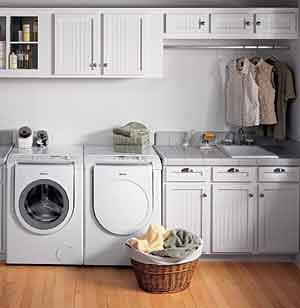Specifying Residential Appliances: Green Update
Clothes Washers
Heating water generates up to 86 percent of the energy consumed by a clothes washer. Hence, specifications for washers should address both energy and water usage. Most sources agree that consideration should be given to horizontal axis (H-axis) front-loading machines. According to RMI, "These use about half to a third of the energy of conventional vertical-axis top-loaders because they need less water to get the same load just as clean. They also have a faster spin speed than vertical axis machines, meaning that clothes will require less drying energy as a result. The energy, water, and detergent saved will cut annual washing costs by about $65, and pay back the higher up-front cost in three to nine years."
|
Greenbuilder.com has identified the following specification features and options that affect the amount of hot water used and the overall efficiency of a clothes washer:
- Wash and rinse cycles: Select a model with many choices. Warm wash cycles clean very well. Only oily stains may require hot washes. Cold-water washing is adequate with proper detergents and pre-soaking and cold rinses are effective. "Suds-saver" (reusing slightly soiled wash water) and pre-soaking are energy conserving options.
- Water level controls: Generally, washing a full load is most efficient, however, a small load should have the option of using a smaller amount of water.
- Water extraction: Higher spin speeds will reduce drying times.
- ENERGY STAR® rating: In addition to all the above, specify a model that meets or exceeds the ENERGY STAR® rating requirement for energy and water usage.
Clothes Dryers
The fundamental specification choice is between electric and gas-fired models. In terms of comparative energy use, gas dryers are generally less expensive to operate. However, since there is no requirement to display the Energy Guide label on clothes dryers, it is not easy to compare the energy use of various dryer models. Most sources agree that there is not a lot of variation in overall energy use between models. Typically, usage and running time dictate the amount of energy used.
Beyond fuel type, controls for turning off dryers become the major specification consideration for energy consumption. The first choice is whether or not the dryer uses sensors to automatically turn off the dryer once clothes are dry. The alternative is timed drying, leaving the running time, and corresponding energy use, to guesswork of the user. The best dryers have moisture sensors inside the drum for sensing dryness and turning off the machine. Most others only infer dryness by using temperature sensors in the exhaust air portion of the dryer, which may result in running the dryer longer than needed. Compared with timed drying, savings of about 10 percent with temperature-sensing controls, and 15 percent with moisture-sensing controls, are possible.
The ENERGY STAR® program currently does not rate clothes dryers, so the specifications should not reference it, but instead, stand alone.










